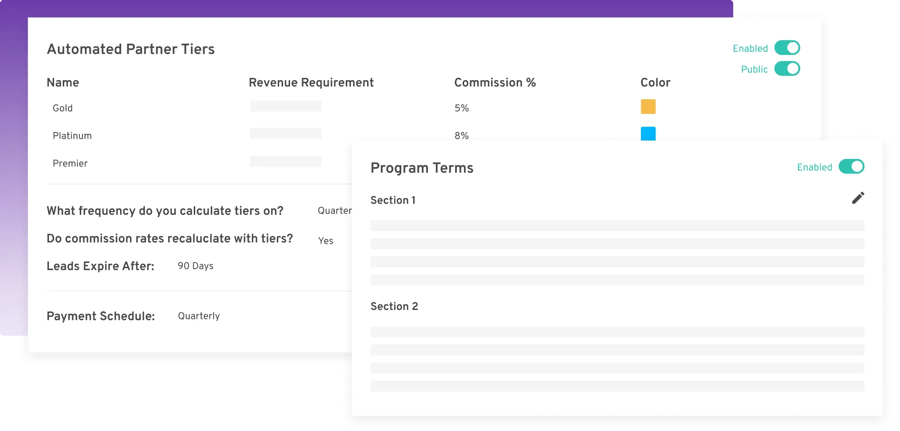With 14 new SaaS companies hitting the market each week, a partner program is essential for survival and growth. Partnering with companies that have a mutual customer base can boost brand exposure and direct revenue, but it also presents the opportunity to break into new ecosystems for your company.
Designing your own partner program can seem daunting, especially without a direct path to revenue. Below, we’ll discuss the different types of partner programs and explain how to set one up successfully.

No matter your SaaS solution, partner programs are essential to your growth and success as a company. But what are they?
what is a partner program?
A partner program is when a B2B company partners with another to expand sales, increase brand awareness, or grow its customer base. There are many different types of partner programs, each with its benefits and advantages. Let's dive in to three common types:
1) Referral / Affiliate Programs
This pay-for-performance model is open to customers and external publishers. Referral programs are less resource-dependent as they reward (or incentivize) partners with a discount or credit for each referral.
The affiliate structure is 'pay per action,' so when a referred person signs up for an account or fills out a form, the referrer gets a commission. Affiliate and referral programs can be more revenue-intensive than other partner programs, but they positively introduce the ability to influence and engage new customers at scale.
2) Technology Partnerships
With a technology or strategic product partnership, the common goal is improving the value for joint customers while integrating technology.
Zapier, for example, has integrations with other software like Slack, Google Drive, and HubSpot to expand their offering and create an end-to-end solution for their customers. Partnering to create a more full-service solution adds value to both the customers and partners.
3) Sales / Support Partnerships
If consultants or agencies work with clients who need your products or services, you can launch a partner program to get more sales. Agencies can also provide clients with advanced support, which takes the strain off your sales and customer support team. Partnering with an agency can greatly boost a company’s revenue and customer base.
Some additional partners types include service providers, product platforms, and complementary agencies.
Now that we understand what a partner program is, let's explore how to prepare and launch one to ensure success. Remember that each partnership represents new potential to expand your revenue and reach!

prepare and launch a B2B Partner Program
1) Define the Strategy
Before starting any partnership, it’s necessary to define the goals and objectives.
If the goal is to amplify revenue or enhance brand association, a company should partner with an agency that has a shared customer base. If the goal is to boost sales engagement, launching an affiliate program may be the best strategy.
Or, suppose a company wants to provide a full-service solution for your customer. In that case, they’d want to focus on the application and integration of their services with other partners, give partners additional development resources, and consider API strategy discussions.
2) Implement the Structure
There are different scopes of B2B partner programs, with varying degrees of support and engagement, per the examples below. Within each scope, you can provide tiered incentives to reward your partners for short and long term engagement.
- Scope A: Partners receive integration documentation, basic support for developing your integration, and sales training for affiliates.
- Scope B: Partners refer new leads or have a mutual customer base, so the company provides a co-marketing strategy that can include co-branding and shared lead generation efforts.
- Scope C: Your co-marketing strategy is taken a step further. This high-level collaboration could include: an industry conference where the partners meet with your customers, a user group meeting to discuss integrations, first access to products or forming an advisory board.
3) Communicate with Your Partners
Once the strategy and structure are defined, communicate with partners about the outcomes you want from the partnership. Be clear with the added value your company can provide in exchange.
Communicate expectations and commitments with each partner, as well as specific goals and benefits to enhance performance.
4) Track Results
Companies will also need a platform to track revenue, close rates, and payments easily. A partner portal can streamline the process of tracking and monitoring leads, make sure to also check out our Metrics feature that provides the full impact.
Although companies can use a spreadsheet, they’ll eventually need to scale. By tracking progress and communicating often, companies create a win-win relationship for themselves and their partners. Communicating and managing relationships is much easier with a partner portal.
How Can We Help?
Having many different types of partners can get complicated — PartnerPortal.io tracks close rates, commission payments and revenue all on one platform, as well as provides centralized communication, resource sharing and metrics of partner performance.
Whether you're planning to introduce one type of partner or offer a combination of multiple, we can provide a custom environment that will automate it all. Make sure to book a free demo today.